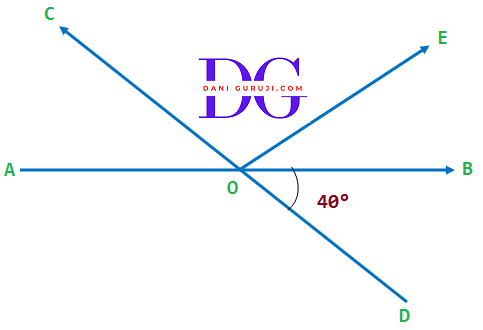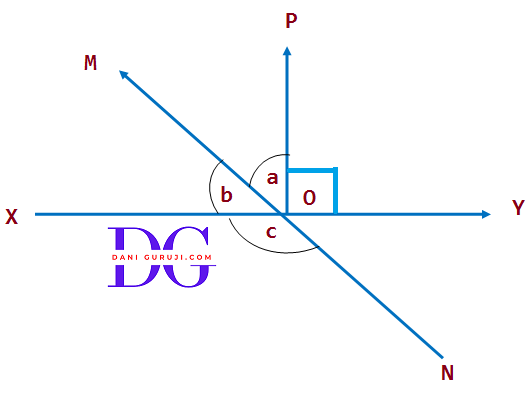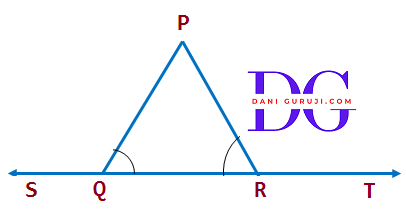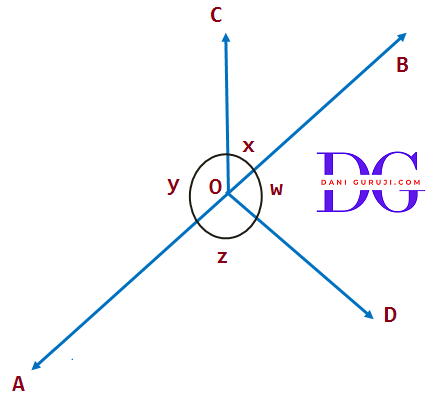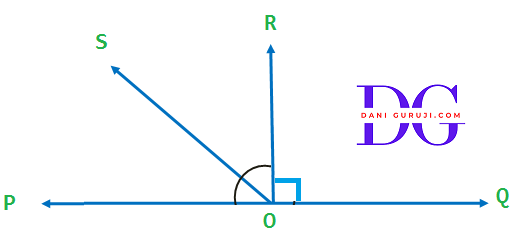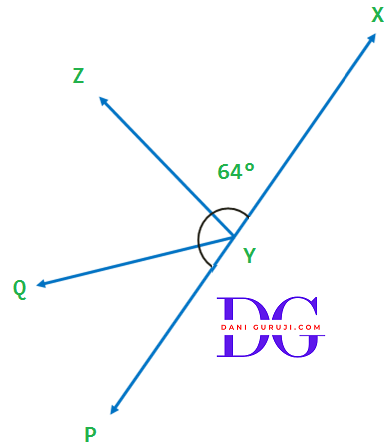In the figure, lines AB and CD intersect at O . If $ \angle $ AOC + $ \angle $ BOE = 70° and $ \angle $ BOD = 40°, find $ \angle $ BOE and reflex $ \angle $ COE.
Solution :
Given, $ \angle $ AOC + $ \angle $ BOE = 70° and $ \angle $ BOD = 40°
OA and OB are opposite rays, Therefore AB is a line.
Since ray OC stands in a straight line AB
( ∵ Sum of linear pair is always 180° )
∴ $ \angle $ AOC + $ \angle $ BOC = 180°
Calculate $ \angle $ COE
⇒ $ \angle $ AOC + $ \angle $ COE + $ \angle $ BOE = 180°
( ∵ $ \angle $ BOC = $ \angle $ COE + $ \angle $ BOE )
⇒ ($ \angle $ AOC + $ \angle $ BOE )+ $ \angle $ COE = 180°
( ∵ Given, $ \angle $ AOC + $ \angle $ BOE = 70° )
⇒ 70° + $ \angle $ COE = 180°
⇒ $ \angle $ COE = 180° - 70° = 110°
Calculate Reflex $ \angle $ COE
( The sum of all angles around a Point is equal to 360° )
Now, Reflex $ \angle $ COE = 360° - $ \angle $ COE
∴ Reflex $ \angle $ COE = 360° - 110° = 250°
Calculate $ \angle $ BOE
⇒ Now, OC and OD are opposite rays, Therefore CD is a line.
Since ray OE stands in a straight line CD
⇒ $ \angle $ COE + $ \angle $ BOE + $ \angle $ BOD = 180°
( ∵ Sum of linear pair is always 180° )
⇒ 110° + $ \angle $ BOE + 40°= 180°
( ∵ $ \angle $ COE = 110° proved above and Given, $ \angle $ BOD = 40° )
⇒ 150° + $ \angle $ BOE = 180°
⇒ $ \angle $ BOE = 180° - 150°
⇒ $ \angle $ BOE = 30°
Hence, $ \angle $ BOE = 30° and Reflex $ \angle $ COE = 250°
In the figure, lines XY and MN intersect at O. If $ \angle $ POY = 90° and a: b = 2 : 3, find c
Solution :
Given, a: b = 2 : 3 and $ \angle $ POY = 90°
OX and OY are opposite rays, Therefore XY is a line.
Since ray OP stands in a straight line XY
( ∵ Sum of linear pair is always 180° )
Calculate $ \angle $ XOP
∴ $ \angle $ XOP + $ \angle $ POY = 180°
( ∵ Given, $ \angle $ POY = 90° )
∴ $ \angle $ XOP = 180° - 90° = 90°
( ∵ $ \angle $ XOP = $ \angle $ XOM + $ \angle $ MOP )
⇒ $ \angle $ XOM + $ \angle $ MOP = 90°
⇒ b + a = 90°
2. Find the values of a and b using the ratio
Since a and b are in the ratio 2 : 3
∴ Let a = 2x and b = 3x
⇒ 2x + 3x = 90°
⇒ 5x = 90°
⇒ x = 18°
Now, since a = 2x , Substituting value of x
⇒ a = 2 × 18°
⇒a = 36°
Now, since b = 3x , Substituting value of x
⇒ b = 3 × 18°
⇒b = 54°
3. Find the value of c
Now, Since ray OX stands in a straight line MN
$ \angle $ XOM + $ \angle $ XON = 180°
( ∵ Sum of linear pair is always 180° )
( ∵ $ \angle $ XOM = b and $ \angle $ XON = c )
⇒ b + c = 180°
( ∵ $ \angle $ XOM = b = 54° proved above )
⇒ 54° + c = 180°
⇒ c = 180° - 54° = 126°
Answer c = 126°
In the figure, $ \angle $ PQR = $ \angle $ PRQ, then prove that $ \angle $ PQS = $ \angle $ PRT.
Solution :
Given, $ \angle $ PQR = $ \angle $ PRQ
To prove, $ \angle $ PQS = $ \angle $ PRT
QS and QR are opposite rays, Therefore SR is a line.
Since ray QP stands in a straight line SR
( ∵ Sum of linear pair is always 180° )
∴ $ \angle $ PQS + $ \angle $ PQR = 180° .. ... (i)
Similarly RT and QR are opposite rays, Therefore QT is a line.
Since ray RP stands in a straight line QT
( ∵ Sum of linear pair is always 180° )
∴ $ \angle $ PRQ + $ \angle $ PRT = 180° ......(ii)
Now, from equation (i) and equation (ii)
⇒ $ \angle $ PQS + $ \angle $ PQR = $ \angle $ PRQ + $ \angle $ PRT
( ∵ Given, $ \angle $ PQR = $ \angle $ PRQ, Now, substituting $ \angle $ PQR at the place of $ \angle $ PRQ in above expression )
⇒ $ \angle $ PQS + $ \angle $ PQR = $ \angle $ PQR + $ \angle $ PRT
⇒ $ \angle $ PQS +
$ \angle $ PQR-$ \angle $ PQR= $ \angle $ PRT⇒ $ \angle $ PQS = $ \angle $ PRT
Hence Proved,
In the figure,if x + y = w + z, then prove that AOB is a line.
Solution :
Given, x + y = w + z
To prove : AOB is a line
$ \angle $ x + $ \angle $ y + $ \angle $ w + $ \angle $ z = 360°
( ∵ The sum of all angles around a Point is equal to 360° )
∴ (x + y )+ (x + y ) = 360°
( ∵ Given, x + y = w + z )
⇒ 2x + 2y = 360°
⇒ 2(x + y) = 360°
⇒ x + y = 180°
Therefore, x and y form a linear pair.
Hence, AOB is a straight line. Proved.
In the figure, POQ is a line. Ray OR is perpendicular to line PQ. OS is another ray lying between rays OP and OR. Prove that $ \angle $ ROS = 1/2 ($ \angle $ QOS – $ \angle $ POS)
Solution :
Given, OR is perpendicular to PQ
To prove : $ \angle $ ROS = 1/2 ($ \angle $ QOS – $ \angle $ POS)
According to the question,
$ \angle $ POR = $ \angle $ QOR = 90°
( ∵ OR is perpendicular to line PQ )
$ \angle $ POR = $ \angle $ QOR
( ∵ $ \angle $ POR = $ \angle $ POS + $ \angle $ ROS )
( ∵ $ \angle $ QOR = $ \angle $ QOS - $ \angle $ ROS )
⇒ $ \angle $ POS + $ \angle $ ROS = $ \angle $ QOS - $ \angle $ ROS
⇒ 2($ \angle $ ROS) = $ \angle $ QOS - $ \angle $ POS
⇒ $ \angle $ ROS = 1/2($ \angle $ QOS - $ \angle $ POS)
Hence Proved.
t is given that $ \angle $ XYZ = 64° and XY is produced to point P. Draw a figure from the given information. If ray YQ bisects $ \angle $ ZYP, find $ \angle $ XYQ and reflex $ \angle $ QYP.
Solution :
Given, $ \angle $ XYZ = 64° . And A ray YQ bisects $ \angle $ ZYP
XY is produced out to point P .
Since ray YZ stands in a straight line XP
( ∵ Sum of linear pair is always 180° )
∴ $ \angle $ XYZ + $ \angle $ ZYP = 180°
(∵ Given, $ \angle $ XYZ = 64° )
⇒ 64° + $ \angle $ ZYP = 180°
⇒ $ \angle $ ZYP = 180° - 64°
⇒ $ \angle $ ZYP = 116°
Since YQ bisects $ \angle $ ZYP
( ∵ $ \angle $ ZYQ = $ \angle $ QYP )
∴ $ \angle $ ZYQ = $ \angle $ QYP = 116°/ 2
Therefore, $ \angle $ ZYQ = $ \angle $ QYP = 58°
Now, $ \angle $ XYQ = $ \angle $ XYZ + $ \angle $ ZYQ
⇒ $ \angle $ XYQ = 64° + 58°
⇒ $ \angle $ XYQ = 122°
Now, reflex $ \angle $ QYP
⇒ 360° - $ \angle $ QYP
( ∵ $ \angle $ QYP = 58° proved above )
⇒ 360° - 58°
Reflex $ \angle $ QYP = 302°
( )
Syllabus for class 10
Advanced courses and exam preparation.
Previous Year Paper
Advanced courses and exam preparation.
Mock Test
Explore programming, data science, and AI.
